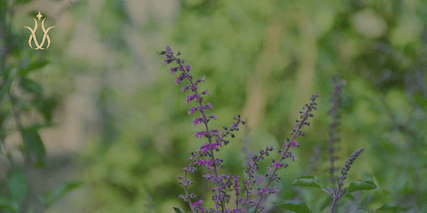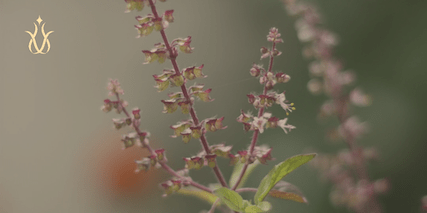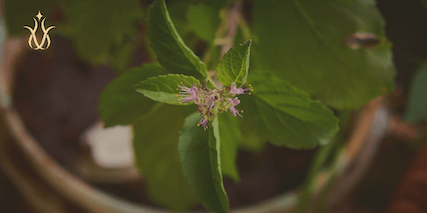Explore the comprehensive guide to Holy Basil in this article. Uncover its diverse uses, remarkable benefits, and potential side effects. Delve into the world of this sacred herb and learn how it can contribute to your well-being.
Introduction
Holy Basil, often referred to as the “Queen of Herbs”, holds a revered position not only in natural medicine but also in cultural and spiritual contexts. Its botanical footprint stretches across various regions, and its extensive healing properties make it a fascinating subject for both herbalists and medical professionals alike.
At its core, Holy Basil, scientifically known as Ocimum sanctum or Ocimum tenuiflorum, stands apart from the culinary basil we sprinkle on our pizzas and pasta. Although from the same basil family, its aromatic leaves, often with a hint of purple, exude a scent distinct from its Mediterranean cousin.
Tracing back the origins of Holy Basil, we find ourselves in ancient India. Here, the herb wasn’t merely seen as one of the many Indian medicinal plants but held a deeper, spiritual significance. In the Indian subcontinent, it was christened “Tulsi” – a name that resonates deeply with Hindu mythology. Tulsi translates to “the incomparable one”, and the herb is often associated with the goddess of the same name.
In Hindu households, Holy Basil is more than just a plant. It’s an embodiment of the divine. Many families nurture a Tulsi plant in their courtyards, and it plays a central role in daily rituals and ceremonies. Beyond its religious importance, Tulsi’s appearance in ancient Ayurvedic scriptures emphasises its healing properties, making it a cornerstone in traditional medicinal practices.
But the tale of Holy Basil doesn’t end in India. Its story is woven through various cultures, from traditional Chinese medicine practices to Greek lore. As trade routes expanded and civilisations interacted, the knowledge of Holy Basil’s benefits spread, cementing its place in herbal remedies across the globe.
So, as we delve deeper into the world of Holy Basil, remember that we’re not just exploring a plant. We’re uncovering centuries of history, tradition, and medical wisdom that have elevated this humble herb to its current esteemed status.
Botanical Description
Embarking on the journey to understand Holy Basil, it’s pivotal to first grasp its botanical anatomy, which sets the foundation for many of its revered benefits.
Plant Characteristics
Dive into any garden fostering Holy Basil, and the first thing to captivate your attention would likely be its robust stature. Unlike its delicate Mediterranean relative, Holy Basil displays a resilience that can be attributed to its evolution in diverse climates.
Leaf Structure and Size: The leaves of the Holy Basil present a unique elliptical shape, broad at the base and tapering towards the tip. Typically, these leaves span anywhere from 2 to 5 cm in length. Their texture, a slightly rugged feel with a hint of softness, underscores the adaptability of the plant.
Flowering Pattern and Appearance: Holy Basil’s blooming season is nothing short of a visual treat. Around mid-summer to early autumn, the flowering plant showcases its delicate raceme inflorescence. Clusters of tiny, tubular flowers, often lavender or purplish in hue, stand out beautifully against the green foliage backdrop. These flowers not only add to the plant’s aesthetic but also play a crucial role in its reproductive cycle, attracting a plethora of pollinators.

Holy Basil Leaves
The leaves of the Holy Basil often termed its powerhouse, encapsulate a world of aromatics and bioactive compounds.
Aromatic Properties and its Unique Compounds: Rubbing a Holy Basil leaf between your fingers releases an intoxicating aroma, a melange of sweet, peppery, and minty notes. This scent can be attributed to the presence of essential oils like eugenol, nerol, and camphor. Beyond just aroma, these oils have been spotlighted in various research studies for their potential therapeutic properties.
The Distinction Between Holy Basil and Common Basil Leaves: To the untrained eye, Holy Basil might seem interchangeable with common basil. However, the difference is palpable, both in appearance and chemical makeup. While common basil leaves are smoother with a shiny veneer, Holy Basil leaves often have a matte finish and may carry subtle purple streaks. Chemically, the eugenol concentration in Holy Basil is markedly higher, which not only differentiates its aroma but also amplifies its medicinal value.
Traditional Uses
Delving into the annals of history, Holy Basil’s role transcends mere cultivation and consumption. Its legacy is deeply interwoven with time-honoured medicinal practices and spiritual beliefs, serving as a beacon of well-being and a symbol of sanctity.
Holy Basil in Ayurveda
Ayurveda, an ancient Indian holistic healing system often referred to as the ‘science of life’, has for millennia held Holy Basil in high esteem.
Historical Significance in Ancient Ayurvedic Scriptures: Charaka Samhita and Sushruta Samhita, pivotal treatises in Ayurvedic medicine, have frequently extolled the virtues of taking Holy Basil. These scriptures detail the herb’s multifaceted role in balancing the doshas – the vital energies governing physiological activity. Holy Basil, or “Tulsi”, as named in Sanskrit, is deemed an adaptogen, a natural substance considered to help the body adapt to stress and exert a normalising effect upon bodily processes.
Methods of Preparation and Administration in Ayurvedic Practices: In Ayurveda, the utility of Holy Basil isn’t confined to its leaves alone. Various parts of the plant – from its stem to seeds – find their way into therapeutic concoctions. A commonly endorsed remedy is the Tulsi tea, made by steeping its leaves, believed to invigorate the senses and fortify immunity. Another prevalent preparation involves crushing its leaves into a juice, often administered to combat respiratory ailments. For skin concerns, the leaves might be ground into a paste, acting as a potent antiseptic.
Holy Basil in Traditional Medicine
Ayurveda isn’t the sole proponent of Holy Basil’s healing properties. Its echoes reverberate across other ancient medicinal practices too.
Role in Traditional Chinese Medicine: In Traditional Chinese Medicine (TCM), Holy Basil, known as “Luole”, is celebrated for its yang properties, thought to restore the body’s vital energy. It’s frequently employed as a counteractive force against the yin conditions, which denote cold and passive aspects. Luole’s inclusion in herbal medicine often aims to rejuvenate the kidneys and stomach, vital organs in TCM’s diagnostic framework.
Uses in Other Indigenous Medicine Systems: Branching out further, we discover Holy Basil’s footprint in African and South American traditional medicine. In these regions, it’s commonly brewed into tonics believed to fend off fever and malaria. Across the oceans, in Thailand, a variant of Holy Basil, known as “Kaprao”, is a staple in culinary dishes and is also valued for its potential anti-diabetic properties.
Spiritual Significance of Holy Basil
Beyond the tangible health benefits, Holy Basil, or ‘Tulsi’ as it’s fondly called, weaves a rich tapestry in spiritual traditions, especially within the annals of Hinduism. Its branches touch the realms of the divine, offering not just medicinal benefits but spiritual ones too.
Role in Hinduism
Holy Basil isn’t merely a plant in the Hindu tradition; it embodies sanctity and divinity, making its mark across rituals and scriptures.
The sight of a Tulsi plant in a traditional Hindu courtyard isn’t accidental. It holds a special place, often within a dedicated structure called ‘Tulsi Vrindavan’. Historically, it’s associated with purity and is believed to ward off evil spirits. Furthermore, Tulsi is revered as the divine manifestation of Goddess Lakshmi, the deity of wealth and prosperity. It graces important ceremonies, from daily worship to grand festivals, with its presence.
The Hindu epics, like the Mahabharata and Ramayana, are peppered with references to the Holy Basil, attesting to its revered status across millennia. It’s not just a symbol of holiness; its leaves often make their way into ritualistic offerings, believed to please the deities and bring divine blessings.
Spiritual Benefits
However, Holy Basil’s significance isn’t just historical or ritualistic. It offers a path to spiritual enhancement, a bridge between the earthly and the ethereal.
Connection to Meditation and Spiritual Practices: A sip of Holy Basil tea or merely being around the plant can prove to be a transformative experience. It’s believed that the plant’s aura aids in meditation, grounding the mind and nurturing a deeper connection to one’s spiritual self. The calming properties, undoubtedly backed by compounds like eugenol, create a conducive environment for introspection and spiritual growth.
Many spiritual practitioners and yogis incorporate Holy Basil into their daily rituals, not just for its health benefits but for its potential to elevate consciousness. Whether it’s through its aroma or its consumption, it supports the journey inwards, fostering a sense of peace and spiritual well-being.
Culinary Uses of Holy Basil
Beyond the confines of medicine cabinets and spiritual altars, Holy Basil has also found its rightful place amidst sizzling pans and simmering pots. This culinary journey is as tantalising to the taste buds as its health benefits are to the body.
Holy Basil in Cooking
Holy Basil’s culinary story is rich and varied and spans multiple cultures. From the fragrant curries of India to the spicy stir-fries of Thailand, this herb graces many a dish, imparting a unique aroma and flavour.
Traditional Recipes and Dishes Using Holy Basil: In the heart of India, especially in its northern regions, a traditional dish known as ‘Tulsi ki Kadhi’ incorporates Holy Basil leaves, yoghurt, and spices, creating a tangy and flavourful concoction. Moving further east, in Thailand, ‘Pad Krapow Moo’ (Pork Stir Fry with Holy Basil) is a beloved dish. It marries the spicy undertones of chillies with the aromatic punch of Holy Basil, offering an explosive taste profile.
The Impact on Flavor and its Unique Taste Profile: Holy Basil isn’t just an addition; it’s often the soul of the dish. Its taste profile is intricate – an ensemble of peppery and slightly sweet notes with a touch of earthiness. When introduced to heat, its aromatic compounds are released, imbuing dishes with a complexity that’s both invigorating and comforting.
Popular Holy Basil Recipes
Globally, the culinary charm of Holy Basil has been embraced and experimented with. Here’s a curated list of dishes that sing praises of this herb:
- Tulsi Tea: Not strictly a dish, but a soothing beverage made by steeping Holy Basil leaves. Popular in Indian households, it’s believed to boost immunity and provide a calmative effect.
- Green Tulsi Curry: A fragrant curry from South India, blending the richness of coconut milk with the refreshing notes of Holy Basil.
- Tulsi Pesto: An innovative fusion, replacing traditional basil with Holy Basil, offering a more peppery and robust twist to the Italian classic.
- Thai Holy Basil Chicken (Gai Pad Krapow): A spicy, savoury stir-fry that harmoniously blends the fiery flavour of chillies with the cooling essence of Holy Basil.
- Holy Basil Tempura: A Japanese inspiration where Holy Basil leaves are lightly battered and fried, making for a crunchy, aromatic treat.

Medicinal Benefits of Holy Basil
The acclaim of Holy Basil transcends the boundaries of spiritual reverence and culinary delight, marking a potent footprint in the realm of medicinal science. Years of research and myriad clinical trials provide a robust backbone to its therapeutic potential, fortifying its age-old stature as a ‘healer’.
Anti-inflammatory Properties of Holy Basil
Inflammation, while a natural defensive response, can, when chronic, have deleterious effects on health. Holy Basil steps in as a natural counteractant.
Scientific Studies Indicating its Effects on Inflammation: Compounds like eugenol, carvacrol, and methyl eugenol found in Holy Basil have demonstrated anti-inflammatory effects in several laboratory studies. For instance, a 2016 research published in the Journal of Clinical Immunology elucidated how the Holy Basil extract inhibited the production of pro-inflammatory cytokines, thus potentially curtailing inflammatory responses in the body.
Holy Basil for Stress Alleviation
The hustle and bustle of modern life have made stress an unwelcome constant for many. Enter Holy Basil, with its adaptogenic properties offering a glimmer of reprieve.
Eugenol is known to possess calming effects on the nervous system, potentially alleviating anxiety symptoms. Rosmarinic acid, on the other hand, can inhibit the activity of the enzyme GABA transaminase, leading to increased levels of the neurotransmitter GABA, often associated with relaxation.
Evidence of Holy Basil’s adaptogenic properties comes from a 2017 study in the Journal of Ayurveda and Integrative Medicine, which found that ocimum sanctum leaf extract enhanced the body’s response to physical and emotional stress, possibly by modulating the release of stress hormones.
Antioxidants
Free radicals, molecules with unpaired electrons, wreak havoc by damaging cells and DNA. Antioxidants are nature’s defence against this menace.
Holy Basil is laden with potent antioxidants like vicenin, orientin, and beta-carotene. These compounds neutralise free radicals, preventing potential oxidative stress.
By curbing oxidative stress, these antioxidants play a pivotal role in mitigating the risk of chronic diseases, improving skin health, and potentially slowing the aging process.
Holy Basil for Diabetes
The surge in diabetes cases globally necessitates natural adjuncts that can support conventional treatments.
A study published in the Journal of Ethnopharmacology in 2014 revealed how Holy Basil extract might enhance insulin secretion and sensitivity, thereby aiding in the regulation of blood sugar levels.
Holy Basil for Immune Support
The immune system, our body’s frontline defence, benefits significantly from Holy Basil’s therapeutic properties.
Holy Basil fortifies the immune response through multiple avenues. Compounds like apigenin enhance the activity of macrophages, the body’s pathogen-eating cells. Moreover, its antimicrobial properties provide an added shield against bacterial, viral, and fungal infections.
Mental Health Benefits of Holy Basil
The tapestry of our mental well-being is intricate and influenced by both internal and external factors. Interestingly, Mother Nature offers an array of remedies, one of which stands out – Holy Basil. Diving deeper into its role, we uncover how this humble herb might alleviate certain mental health concerns.
Holy Basil for Anxiety Relief
A restive mind, often ensnared in a web of worries, seeks relief and calm. Holy Basil, through its bioactive compounds, potentially offers this solace.
Compounds such as eugenol, rosmarinic acid, and oleanolic acid found in Holy Basil exhibit potential anxiolytic or anxiety-reducing properties. These compounds might modulate neurotransmitter activity in the brain, especially influencing GABAergic pathways and promoting a sense of calm and tranquillity and improved cognitive function.
Scientific research published in the Journal of Ayurveda and Integrative Medicine in 2016 indicated that taking Holy Basil extract might significantly reduce general anxiety disorder symptoms, with potential improvement in associated depression and sleep disturbances.
Holy Basil for Depression
Depression, a pressing global concern, necessitates diverse therapeutic approaches. Holy Basil emerges as a potential natural adjunct.
A 2015 study from the Asian Pacific Journal of Tropical Biomedicine demonstrated how Tulsi leaf extract might exhibit antidepressant activities comparable to standard drugs, particularly in rodent models.
Possible Mechanisms of Action: The potential antidepressant effect of taking Tulsi leaf extract may be attributed to its ability to modulate serotonin and dopamine levels, two key neurotransmitters implicated in mood regulation.
Skin and Hair Benefits of Holy Basil
From the crown of our heads to the tip of our toes, Holy Basil’s therapeutic touch extends, promising radiant skin and lustrous locks.
Holy Basil for Acne Management
Those red, inflamed blemishes aren’t just skin-deep; they affect self-esteem. Thankfully, Holy Basil’s properties might offer respite.
Holy Basil’s potent antimicrobial effects, stemming from compounds like eugenol, make it a potential adversary to acne-causing bacteria. A 2013 study in the International Journal of Cosmetic Science highlighted the clinical efficacy of topical applications containing Holy Basil leaf extract in reducing acne lesions over time.
Holy Basil for Hair Growth
A thick, healthy mane is often synonymous with vitality. Holy Basil’s nutritional arsenal might hold the key to unlocking hair’s potential.
Enriched with vitamins like vitamin K and antioxidants, Holy Basil may support scalp health, potentially improving blood circulation and strengthening hair follicles.
Research published in the Journal of Ethnopharmacology in 2017 indicated that compounds in Holy Basil may stimulate hair follicle growth and function, supporting its traditional use in hair care routines.
Safety and Side Effects
Whenever we embark on a journey with herbal supplements, it’s not just the benefits we need to take into account. Like any remedy, Holy Basil has its intricacies, and understanding the safety and possible side effects is paramount.
Documented Side Effects
Even nature’s most revered herbs come with their sets of cautions. Holy Basil, despite its profound benefits, isn’t an exception.
Possible Interactions with Medications: Taking Holy Basil may influence blood clotting due to its antiplatelet effects, potentially increasing the risk of bleeding when taken with anticoagulant drugs. Furthermore, its hypoglycaemic activity can amplify the effects of diabetes medications, necessitating close monitoring of blood sugar levels.
General Precautions for Specific Populations: Pregnant or breastfeeding women should exercise caution before taking Holy basil. The eugenol content, albeit therapeutic, can potentially lead to contractions, making it advisable to avoid it during pregnancy. Furthermore, lactating mothers should be cautious as the safety profile of taking Holy Basil during breastfeeding isn’t comprehensively studied.
Allergies
Every individual’s body reacts uniquely to substances. Allergic reactions, although rare with Holy Basil, may occur.
Signs of Allergic Reactions and Precautions: Side effects symptoms might range from mild skin rashes to more severe reactions like difficulty breathing. If any signs of an allergic reaction emerge after taking Holy Basil, it’s imperative to discontinue use and consult your healthcare provider immediately.
Supplements and Dosage
The beauty of Holy Basil transcends its traditional leafy form, extending into the realm of modern supplements. Let’s delve into its encapsulated avatars and decode the dosages.
Popular Holy Basil Capsules
Capsules bring convenience, but how do they fare against raw leaves or teas?
Capsules typically contain concentrated Holy Basil leaf extracts, aiming to deliver therapeutic compounds like eugenol and rosmarinic acid in precise dosages. Compared to raw leaves or teas, they offer a more controlled intake but might lack the holistic experience of consuming the plant in its natural form.
Studies, including one published in Phytomedicine in 2017, have shown that taking Holy Basil capsules might provide comparable therapeutic benefits to raw leaves, especially in terms of adaptogenic and antioxidant effects.
Recommended Dosage
Navigating the right dosage is essential for harnessing Holy Basil’s benefits without overstepping the bounds of safety.
For general well-being, 300-600 mg of standardised Holy Basil leaf extract is commonly recommended. However, for specific conditions like anxiety or elevated blood sugar levels, dosages might vary and should always be tailored under professional guidance.
Always start with the lower end of the dosage spectrum and monitor your body’s reactions. It’s also essential to maintain a gap between Holy Basil intake and other medications, typically 2-3 hours, to avoid potential interactions.

Cultivation
Growing Holy Basil (Tulsi) isn’t just an agricultural venture; it’s a journey into the heart of a plant steeped in historical and medicinal richness. However, ensuring that this revered herb thrives requires specific conditions and care.
From the sun-drenched fields of India to the greenhouses in colder climates, Holy Basil finds its roots in diverse terrains. However, certain conditions can help it flourish better.
Ideal Soil Conditions: The Holy Basil plant thrives in well-draining soil. A mixture of loam and sand serves as an ideal medium. The pH level should ideally hover between 6 to 7.5. While the plant is adaptable, it does appreciate rich soil, so occasional compost or organic fertilisers can be beneficial.
Climate: While Holy Basil is native to tropical regions, it’s resilient and can adjust to various climates. However, it does prefer warm conditions. A temperature range of 18°C to 32°C is ideal.
Care Tips
Understanding the Holy basil plant’s needs ensures that it remains hearty and ready to offer its many benefits.
Watering: The Holy Basil plant isn’t too demanding. Water it when the soil feels dry about an inch deep. It’s crucial to avoid waterlogging as the plant’s roots might rot.
Sunlight: The Sun is the elixir for Holy Basil. Ensure it receives at least 6 hours of direct sunlight daily. If grown indoors or in regions with limited sunlight, consider supplementing with grow lights.
Pest Management: Though robust, the Holy Basil may sometimes attract aphids or whiteflies. Natural predators like ladybugs can be beneficial, or you can resort to organic insecticidal soaps.
Market & Purchase
Navigating the Holy Basil market is like weaving through a garden – there’s much to see, smell, and select. Knowing where to look and what to consider can make all the difference.
Best Holy Basil Brands
While many brands tout the purity and potency of their Holy Basil products, it’s essential to be discerning. Always look for reviews, preferably from independent testers and trusted health publications, to ensure product integrity. Additionally, check for third-party lab testing and certifications, which add a layer of trustworthiness.
Buying Organic Holy Basil
With increasing global demand, Holy Basil is now grown in various parts of the world. But here’s the rub: Not all are created equal.
Organic Holy Basil ensures you’re getting a product free from pesticides, synthetic fertilisers, and genetically modified organisms. It also means that the farming practices used were sustainable, benefiting the environment. While organic might come at a premium, the peace of mind regarding purity and eco-friendliness often justifies the price.
Conclusion
We’ve journeyed through fields, tapped into age-old wisdom, and unravelled the mystery of a plant – Holy Basil. Its significance, transcending time and borders, is a testament to its unparalleled benefits. Whether you’re sipping its essence in tea or incorporating it into health regimens, remember the rich tapestry it brings – of health, spirituality, and nature. As with all supplements and herbs, consult professionals, do your research, and ensure you’re making informed decisions. In the world of botanicals, Holy Basil truly stands as a green beacon, illuminating paths to wellness and wholeness.
Frequently Asked Questions
What is Tulsi?
Tulsi, also known as Holy Basil, is a revered herb predominantly grown in India and parts of Southeast Asia. It’s not just a medicinal plant; for many, it’s a symbol of sanctity, well-being, and historical legacy. Distinct from the common basil (Ocimum basilicum) used in many kitchens, Tulsi (Ocimum sanctum or Ocimum tenuiflorum) holds a special place in both traditional medicinal systems and spiritual practices.
From a botanical perspective, Tulsi is a perennial herb with delicate lavender-coloured flowers and a strong aromatic scent. This green or sometimes purplish plant has broad, oval-shaped leaves that exude a spicy, sweet aroma when crushed.
But beyond its physical attributes, Tulsi’s real essence lies in its myriad of health benefits. For centuries, it has been a cornerstone in Ayurvedic medicine, a traditional Indian system of healing. Its leaves, seeds, and stems have been used to combat a range of ailments, from common colds to chronic conditions. Packed with antioxidants and bioactive compounds, such as eugenol, rosmarinic acid, and apigenin, Tulsi offers anti-inflammatory, adaptogenic (stress-reducing), and antimicrobial properties.
Spiritually, Tulsi holds a revered position in Hinduism. It is often found in the centre of many Indian courtyards, where it serves not only as a medicinal herb but also as a spiritual icon. Daily rituals involving the watering and lighting of lamps near the Tulsi plant are common, symbolising a divine connection and respect for nature’s healing powers.
In the modern era, the global community has started to embrace Tulsi, not just in its traditional tea form but also as supplements, essential oils, and as a key ingredient in wellness products. However, it stands as a reminder that nature, with its vast biodiversity, has always had solutions to many of our well-being needs; we just need to respect, understand, and utilise them wisely.
Are Tulsi and Basil the same thing?
No, Tulsi and basil are not the same thing, although they belong to the same basil family, commonly known as the mint family, Lamiaceae.
Here’s a breakdown of their differences:
- Names and Varieties:
- Tulsi: Known scientifically as Ocimum sanctum or Ocimum tenuiflorum, it is commonly referred to as Holy Basil in English.
- Basil: The common culinary basil used in many cuisines, especially Italian, is known as Ocimum basilicum and is often referred to as sweet basil.
- Origins and Cultural Significance:
- Tulsi: Native to the Indian subcontinent, Tulsi holds significant religious and cultural importance, especially in Hinduism, where it’s revered as a sacred plant.
- Basil: Sweet basil originates from Central Africa to Southeast Asia. It’s a staple in Mediterranean dishes, especially Italian cuisine like pesto.
- Appearance:
- Tulsi: It usually has purple stems and green or purplish leaves. The Holy basil plant can have a more erect growth habit.
- Basil: Sweet basil has soft, green, and broad leaves with a smoother edge, and it grows in a bushy pattern.
- Flavour and Aroma:
- Tulsi: Has a spicy and complex flavour with peppery notes. Its aroma can be described as clove-like.
- Basil: Has a sweet and mild flavour, with hints of anise and clove. Its aroma is light and sweet.
- Medicinal Uses:
- Tulsi: Widely used in Ayurvedic medicine, Tulsi is known for its adaptogenic properties, helping the body combat stress. It’s also used for a variety of ailments ranging from colds to digestive issues.
- Basil: While also having some medicinal properties, sweet basil’s health benefits are generally less pronounced than Tulsi’s. It’s mostly known for its anti-inflammatory and antioxidant properties.
What is Tulsi tea?
Tulsi tea or Holy Basil tea, often hailed as the “Liquid Yoga,” is a revitalising beverage made from the leaves of the Holy basil plant. Originating from the Indian subcontinent, this aromatic infusion has played a pivotal role in traditional medicinal practices, particularly in Ayurveda, for centuries.
Unlike your typical tea derived from the Camellia sinensis plant, Tulsi tea is a type of herbal tisane. When steeped in hot water, Tulsi leaves release a fragrant aroma and a flavour that dances between peppery and slightly sweet, providing a refreshing and soothing cup.
But Tulsi tea isn’t just appreciated for its delightful taste. It’s packed with beneficial phytochemicals that offer a wealth of health benefits. From its adaptogenic properties, which help the body adapt to stress, to its potential immune-boosting and antioxidant capabilities, a cup of Tulsi tea is often viewed as a cup of holistic well-being.
In recent years, Tulsi tea has gained popularity beyond the boundaries of its origin, finding its way into the kitchens and routines of health enthusiasts worldwide. Whether sipped in the morning to kickstart the day or in the evening for a calming effect, Tulsi tea is a fusion of taste, tradition, and wellness in every cup.
What is Tulsi good for?
Tulsi, also known as Holy Basil, is renowned for its multifaceted health benefits encompassing the realms of health, spirituality, and well-being. Here are some of its key benefits:
- Medicinal and Therapeutic Benefits:
- Adaptogenic Properties: Tulsi helps the body adapt to stress and promotes mental balance.
- Immune Support: It can bolster the immune system, potentially enhancing the body’s resistance to illnesses.
- Anti-inflammatory and Antioxidant: Tulsi contains compounds like eugenol, which offer anti-inflammatory effects. Additionally, its antioxidants combat oxidative stress, protecting cells from damage.
- Blood Sugar Regulation: Some studies suggest that taking Holy Basil may aid in regulating blood sugar levels, beneficial for diabetics.
- Anti-microbial Properties: Tulsi can fight off a range of pathogens, making it useful in preventing infections.
- Heart Health: Taking Holy Basil may help in lowering cholesterol levels, thus supporting heart health.
- Mood Enhancer: Traditionally used to combat depression and anxiety, the herb can act as a mood stabilizer.
- Spiritual and Cultural Significance:
- In Hinduism, Tulsi is considered sacred. It plays a central role in various rituals and prayers and is often grown in homes and temples for its spiritual significance.
- Culinary Uses:
- Tulsi leaves are often used to make refreshing herbal teas.
- Its unique aroma and flavour can be incorporated into various dishes and beverages.
- Skin and Hair Benefits:
- Due to its antimicrobial properties, Tulsi can be beneficial for skin conditions like acne.
- Its antioxidants can help rejuvenate the skin, giving it a radiant glow.
- For hair, Tulsi might promote growth and reduce dandruff and scalp irritations.
- Environmental Benefits:
- Tulsi plants are known to purify the air, absorbing pollutants like sulfur dioxide, making them a green ally in urban settings.
While Tulsi has numerous benefits, it’s always wise to consult with your healthcare provider before incorporating it as a therapeutic remedy, especially if one is pregnant, nursing, or on specific medications.
Is Holy basil oil an essential oil?
Yes, Holy Basil oil, derived from the Tulsi plant (Ocimum sanctum or Ocimum tenuiflorum), is considered an essential oil. Essential oils are concentrated plant extracts that capture the natural scent and flavour, or “essence”, of their source.
Holy Basil essential oil is extracted primarily through steam distillation of the leaves and stems of the plant. It contains various bioactive compounds, including eugenol, camphor, and other terpenes and flavonoids.
This oil is revered for its unique therapeutic properties, which align with the traditional uses of the Holy Basil plant in Ayurvedic medicine. It’s believed to have adaptogenic, antimicrobial, anti-inflammatory, and antioxidant properties.
However, as with all essential oils, it should be used with caution, diluted appropriately, and ideally under the guidance of a trained professional, especially if applied topically or ingested.
Is Holy basil oil the same as Holy basil seed oil?
No, Holy Basil essential oil and Holy Basil or Ocimum Sanctum seed oil are not the same. Here’s a breakdown to elucidate their differences:
1. Source of Extraction:
- Holy Basil oil: This essential oil is primarily extracted from the leaves and sometimes the stems of the Holy Basil (Tulsi) plant, Ocimum sanctum or Ocimum tenuiflorum. The extraction process usually involves steam distillation.
- Holy Basil seed oil: As the name implies, this oil is derived from the seeds of the Holy Basil plant. The extraction method is typically cold pressing, which is common for seed oils.
2. Composition and Properties:
- Holy Basil oil: It’s rich in aroma compounds like eugenol, camphor, and other terpenes, which give the essential oil its unique aroma and therapeutic properties. This oil is often revered for its adaptogenic, antimicrobial, and anti-inflammatory qualities.
- Holy Basil seed oil: Seed oils generally have a different profile of fatty acids and nutrients compared to essential oils. They might be richer in omega fatty acids and other lipids, making them more nourishing and moisturising. Their therapeutic properties might differ from those of essential oils.
3. Applications:
- Holy Basil oil: Often used for its aromatic and therapeutic properties, it might be found in aromatherapy, massage blends, and certain medicinal preparations.
- Holy Basil seed oil: Due to its fatty acid content, it might be more commonly used for skin and hair care, providing moisturising benefits. It can also be used in dietary supplements, given its nutrient profile.
In conclusion, while both oils originate from the Holy Basil plant, their source, composition, and uses differ significantly. It’s essential to understand these differences, especially if you’re considering them for therapeutic or topical applications.
Who should not take Tulsi?
While Tulsi, or Holy Basil, is celebrated for its multitude of health benefits, it’s not suitable for everyone and may cause side effects. Certain individuals should exercise caution or avoid holy basil altogether:
- Pregnant and Nursing Women: Holy basil may have an effect on the menstrual cycle and uterine contractions, making it potentially unsafe during pregnancy. Likewise, nursing mothers should be cautious as there’s limited research on its effects during lactation.
- Individuals Scheduled for Surgery: Due to its potential to slow blood clotting, consuming Holy basil may increase the risk of bleeding. It’s advisable to stop intake at least two weeks before a scheduled surgery.
- People with Hypothyroidism: Tulsi can reduce the levels of thyroid hormone T4. Thus, those with hypothyroidism or those taking medications for it should be careful of this side effect.
- Diabetics on Medication: Holy basil can lower blood sugar levels. When combined with diabetes medications, Holy basil may cause one’s blood sugar to go too low. Close monitoring and consultation with a doctor are essential.
- People on Blood-thinning Medications: Since Tulsi has antiplatelet properties, it might increase the risk of bleeding when taken with drugs that reduce clotting, like aspirin, warfarin, or clopidogrel.
- Those with Low Blood Pressure: While Holy basil may be beneficial for those with high blood pressure, it might lower blood pressure too much in individuals already diagnosed with hypotension.
- Individuals Allergic to Tulsi: Like any herb or plant, some individuals might develop allergies to Tulsi. Side effects can include skin rash, itching, shortness of breath, or even anaphylaxis in severe cases.
In any situation where there’s a doubt about incorporating Tulsi or any herbal supplement into one’s routine, it’s imperative to consult with your healthcare provider. They can provide guidance tailored to individual health profiles and needs.
Resources:
Baliga MS et al (2013). Ocimum sanctum L (Holy Basil or Tulsi) and its phytochemicals in the prevention and treatment of cancer.
Cohen MM (2014). Tulsi – Ocimum sanctum: A herb for all reasons.
Shimizu T (2013). Holy Basil leaf extract decreases tumorigenicity and metastasis of aggressive human pancreatic cancer cells in vitro and in vivo: potential role in therapy. Available at: https://www.sciencedirect.com/science/article/abs/pii/S0304383513002450?via%3Dihub
Web.MD (2020) Holy Basil – Uses, Side Effects, and More. Available at: https://www.webmd.com/vitamins/ai/ingredientmono-1101/holy-basil
Disclaimer: This article is for informational purposes only and should not replace professional medical advice. If you have specific concerns or medical conditions, it is recommended to consult with a healthcare professional for personalised guidance and support.






